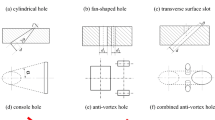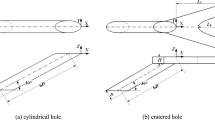Abstract
A numerical study was performed to evaluate the effectiveness of the novel sister hole film cooling technique. Two secondary coolant holes bound the primary coolant hole slightly downstream of its midpoint, intended to minimize the primary vortex pair and improve cooling performance. An unstructured hexahedral mesh was generated and the realizable k–ε turbulence model with near-wall modeling was used in these simulations. Blowing ratios of 0.2, 0.5, 1.0, and 1.5 were simulated to evaluate the applicability of sister holes in practical applications. It was found that sister holes significantly improved cooling performance over the entire computational domain, particularly at high blowing ratios. These results arose by countering the primary vortex pair with a secondary pair from these sister holes, ultimately maintaining flow adhesion where the coolant stream would have otherwise separated.




















Similar content being viewed by others
Abbreviations
- A :
-
Area
- D :
-
Diameter
- DR:
-
Density ratio
- L :
-
Length
- M :
-
Blowing ratio
- Ma :
-
Mach number
- P :
-
Perimeter
- R :
-
Gas constant
- T :
-
Temperature
- V :
-
Velocity
- h :
-
Height
- k :
-
Turbulent kinetic energy
- p :
-
Pitch
- s :
-
Row spacing
- y + :
-
The normalized distance yu */v
- z :
-
Coordinate in the lateral direction
- ε:
-
Dissipation rate of turbulent kinetic energy
- η:
-
Adiabatic effectiveness
- μ:
-
Viscosity
- ρ:
-
Density
- ν:
-
Eddy viscosity
- aw:
-
Adiabatic wall
- c:
-
Coolant
- h:
-
Hydraulic
- t:
-
Turbulent
- w:
-
Wetted
- ∞:
-
Freestream
References
Bogard D, Thole K (2006) Gas turbine film cooling. J Propuls Power 22:249–270
Sargison J, Oldfield M, Guo S, Lock G, Rawlinson A (2005) Flow visualizations of the external flow from a converging slot-hole film cooling geometry. Exp Fluids 38:304–318
Baheri S, Alavi-Tabrizi SP, Jubran BA (2007) Film cooling effectiveness from trenched shaped and compound holes. Heat Mass Transf 44:989–998
Yuen C, Martinez-Botas R (2003) Film cooling characteristics of a single round hole at various streamwise angles in a crossflow: part I effectiveness. Heat Mass Transf 46:221–235
Azzi A, Jubran BA (2003) Numerical modeling of film cooling from short length stream-wise injection holes. Heat Mass Transf 39:344–353
Bergeles G, Gosman AD, Launder BE (1978) The turbulent jet in a cross stream at low injection rates: a three-dimensional numerical treatment. Num Heat Transf 1:217–242
Roy S (2000) Numerical investigation of the blade cooling effect generated by multiple jets issuing at an angle into an incompressible horizontal crossflow. Num Heat Transf Part A 28:701–718
Javadi A, Javadi K, Taeibi-Rahni M, Darbandi A (2003) A new approach to improve film cooling effectiveness using combined jets. In: Proceedings of the international conference on gas turbine cong 2003, paper # TS-071, Tokyo, Japan
Javadi K, Taeibi-Rahni M, Darbandi M (2007) Jet-into-crossflow boundary-layer control: innovation in gas turbine blade cooling. AIAA J 25:2910–2925
Heidmann D (2008) A numerical study of anti-vortex film cooling designs at high blowing ratio. Proc ASME Turbo Expo 2008, GT2008-50845
Dhungel A (2007) Film cooling from a row of holes supplemented with anti-vortex holes. Master’s thesis, Louisiana State University, Baton Rouge, LA
Kusterer K, Bohn D, Sugimoto T, Tanaka R (2007) Double-jet ejection of cooling air for improved film cooling. J Turbomach 29:809–815
Kusterer K, Bohn D, Sugimoto T (2008) Double-jet film-cooling for highly efficient film-cooling with low blowing ratios. Proc ASME Turbo Expo 2008, GT2008-50073
Ajersch P, Zhou J, Ketler S, Salcudean M, Gartshore I (1997) Multiple jets in a crossflow: detailed measurements and numerical simulations. J Turbomach 119:330–342
Harrison, K, Bogard, D (2008) Comparison of RANS turbulence models for prediction of film cooling performance, ASME Turbo Expo 2008, GT2008-51423
Ely M, Jubran BA (2008) A numerical study on improving film cooling performance through the use of sister holes. Proc ASME Turbo Expo 2008, GT2008-50366
Goldstein R, Eckert E, Burggraf F (1974) Effects of hole geometry and density on three-dimensional film cooling. Heat Mass Transf 17:595–607
Gartshore I, Salcudean M, Hassan I (2001) Film cooling injection hole geometry: hole shape comparison for compound cooling orientation. AIAA J 39:1493–1499
Yavuzkurt S, Habte M (2008) Effect of computational grid on performance of two-equation models of turbulence for film cooling applications, ASME Turbo Expo 2008, GT2008-50153
Shih T, Liou W, Shabbir A, Yang Z, Zhu J (1995) A new k–ε eddy-viscosity model for high Reynolds number turbulent flows—model development and validation. Comp Fluids 24:227–238
Inc FLUENT (2003) Fluent 6.1 users guide. FLUENT Inc., Lebanon, NH
Sinha A, Bogard D, Crawford N (1991) Film cooling effectiveness downstream of a single row of holes with variable density ratio. J Turbomach 113:442–449
Na S, Shih T (2007) Increasing adiabatic film-cooling effectiveness by using an upstream ramp. J Heat Transf 129:464–471
Acknowledgments
The authors would like to extend their thanks to the Natural Science and Engineering Research Council of Canada and the Province of Ontario for their funding towards this research. Special thanks are also due to the High Performance Computing Virtual Laboratory for their financial support and extensive resources.
Author information
Authors and Affiliations
Corresponding author
Rights and permissions
About this article
Cite this article
Ely, M.J., Jubran, B.A. A numerical evaluation on the effect of sister holes on film cooling effectiveness and the surrounding flow field. Heat Mass Transfer 45, 1435–1446 (2009). https://doi.org/10.1007/s00231-009-0523-8
Received:
Accepted:
Published:
Issue Date:
DOI: https://doi.org/10.1007/s00231-009-0523-8




